Oracle Autonomous Health Framework (AHF) helps maximize application resilience, performance, and security through AI-driven proactive issue prevention and resolution
It’s the same technology Oracle uses in the cloud to keep the Autonomous Database running, and it’s available for you at no extra cost as part of your existing software support agreement.
Autonomous Health Framework 24.9 is released and available to download
New Features in 24.9
- Database Performance Tuning Made Easier
- Detect New Causes of Node Eviction and Database Slow Performance
- Easier to Ensure Oracle Data Guard Readiness
- Database Monitoring Via Database User Credentials
- Best Practice Reporting for Latest Security Risks
- New Best Practice Checks
- Latest Third-Party Libraries
Database Performance Tuning Made Easier
A new Performance Reports section has been added to AHF Insights, which includes PerfHub, AWR and AWR Compare reports.
AHF captures diagnostic data required for performance tuning in the dbperf SRDC via the command:
tfactl diagcollect -srdc dbperf -database db_nameAHF now embeds the most useful performance tuning reports, directly within the AHF Insights report.
A new Performance Reports section has been created, which contains:
- PerfHub Reports
- AWR Reports
- AWR Compare Reports
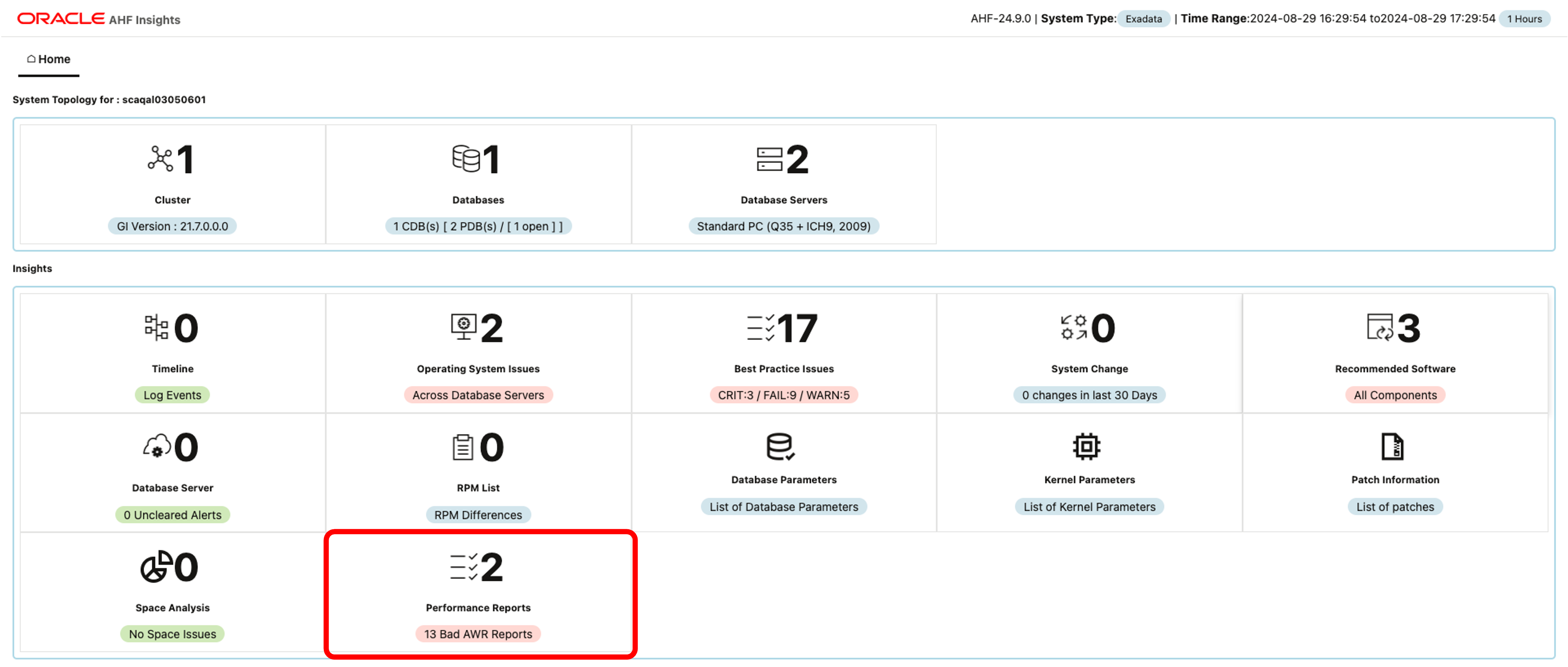
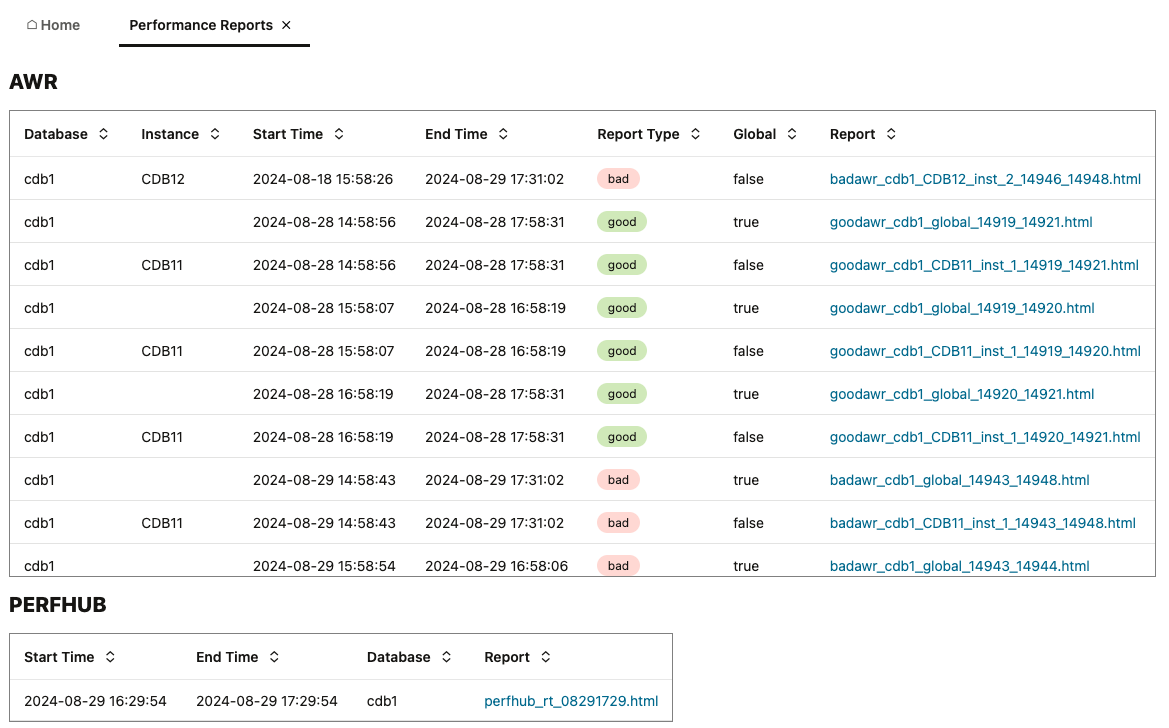
Open the PerfHub report.
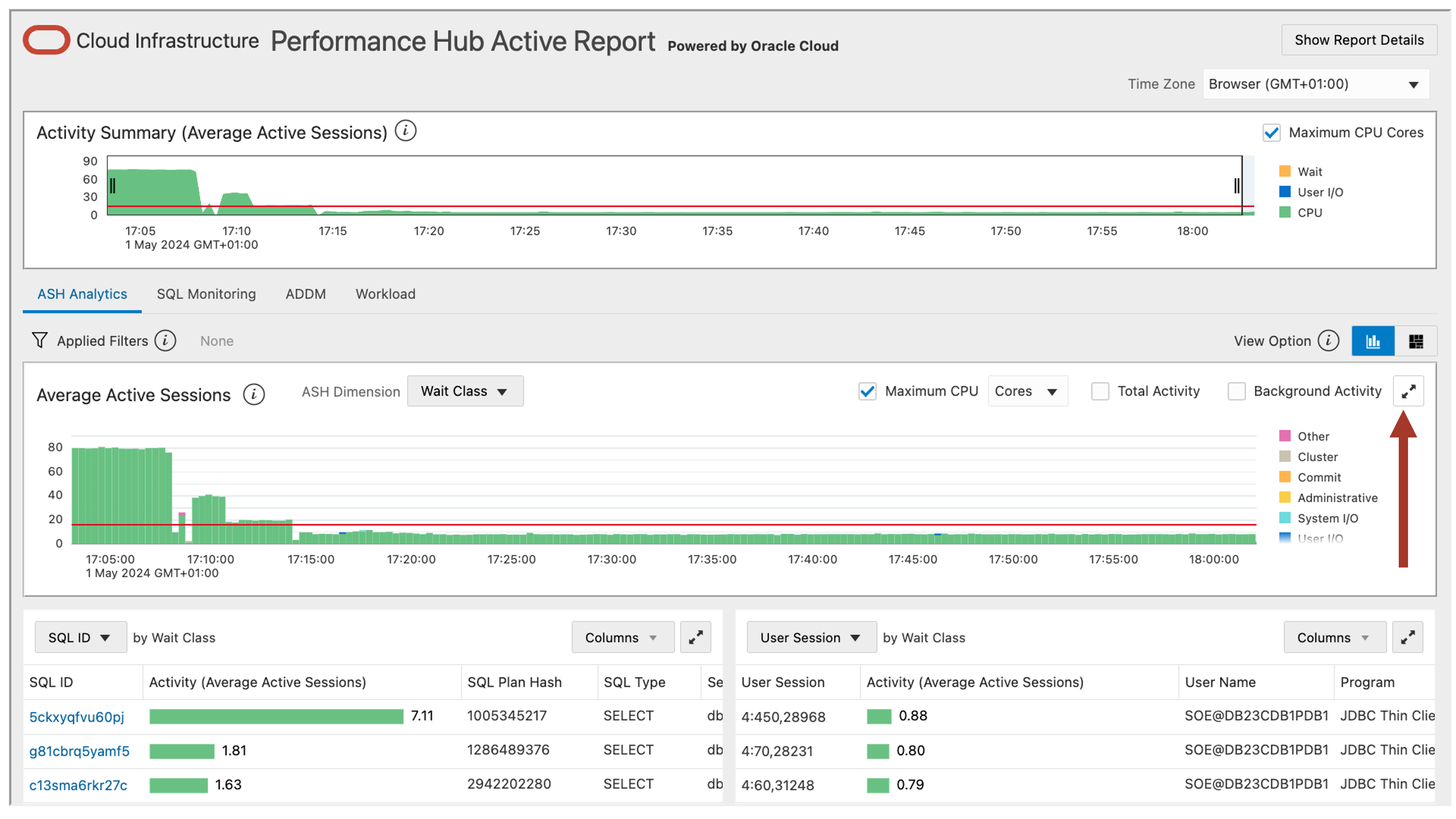
To make use of the new Performance Reports section:
- Run:
tfactl diagcollect -srdc dbperf -database db_name - Extract the resulting diagnostic collection and open the Insights report
- Navigate to the Performance Reports section and open the appropriate report
For more information on how to use the resulting performance reports see database performance tuning.
Detect New Causes of Node Eviction and Database Slow Performance
AHF now automatically detects new causes of node eviction, instance eviction and database slow performance, showing summary of the problem, cause and resolution in Insights.
Since version 24.4 AHF has had the ability to detect problems and show a summary with the resolution. The Problem Summary page is available under the Detected Problems panel in Insights.
This release adds the ability to automatically detect the following new problems:
- Node evictions due to High CPU Steal
- Database slow performance due to poorly sized network message buffers
- Database slow performance due to incorrect configuration of recovery blocks
To generate a diagnostic collection run tfactl diagcollect then follow the prompts to select the issue of interest.
Transfer the resulting zip to a machine with a browser, open the Insights report and view the Detected Problems.
See the user guide for more information on resolving problems AHF has detected.
Easier to Ensure Oracle Data Guard Readiness
AHF Insights Data Guard section now computes failover and readiness, compares configuration between primary and secondary and highlights database performance metrics.
When using Oracle Data Guard, calculating switchover and failover readiness can be complicated and ensuring symmetry of config is critical.
In 24.5 AHF introduced the Data Guard health report in Insights. This functionality has now been redesigned and expanded, and is accessible from the Data Guard panel.
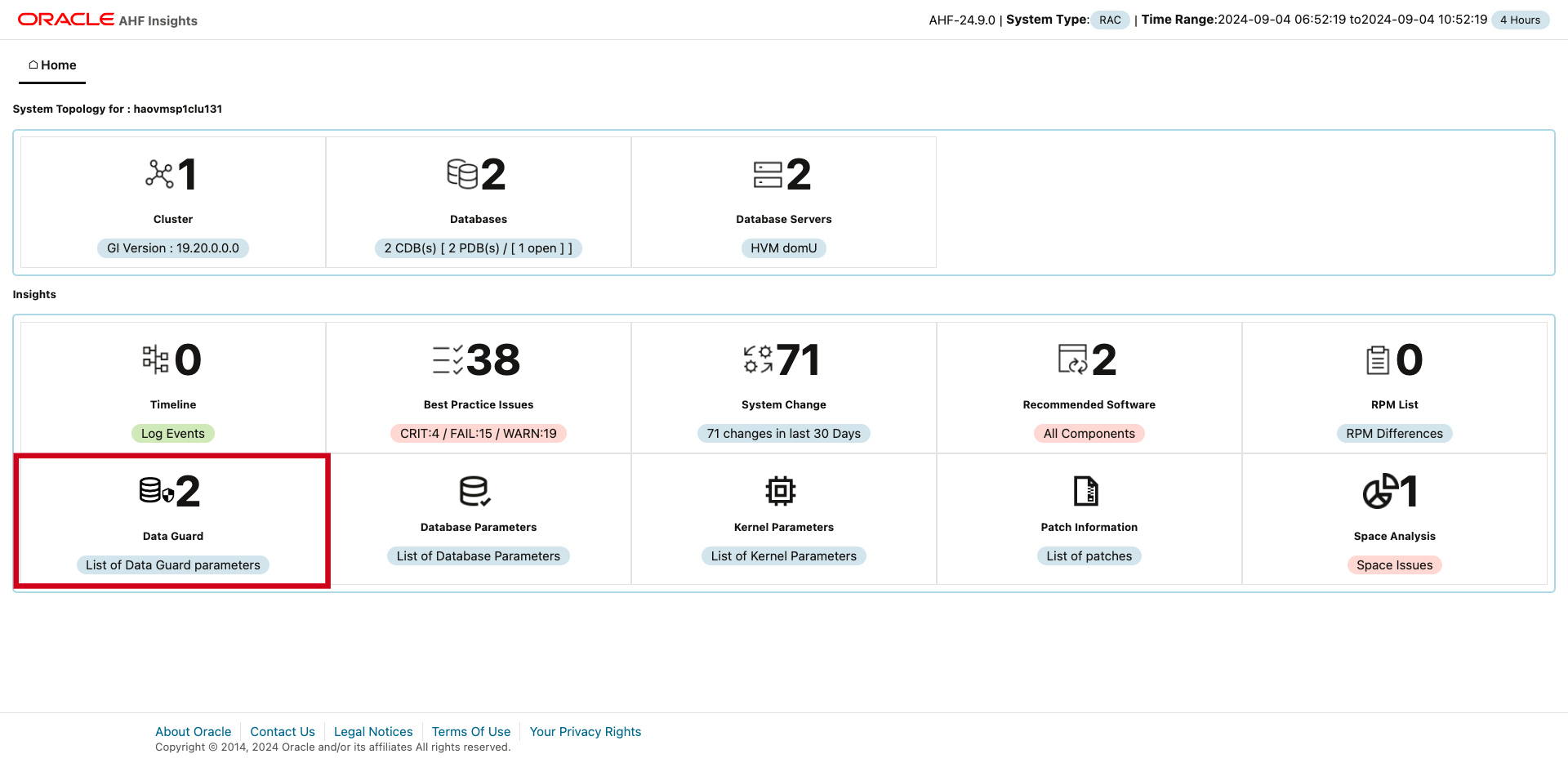
A new Configuration page has been added, which includes:
- Data Guard configuration, including Switchover and Failover Readiness calculations
- Database list, showing the roles and state of each member
- Transport lag, Apply lag and Average Apply rate

The lags and apply rate can be used to help identify any problems that exist with the redo transport services and the log apply services, and they can also help to determine whether or not the standby database is able to keep up with the primary database.
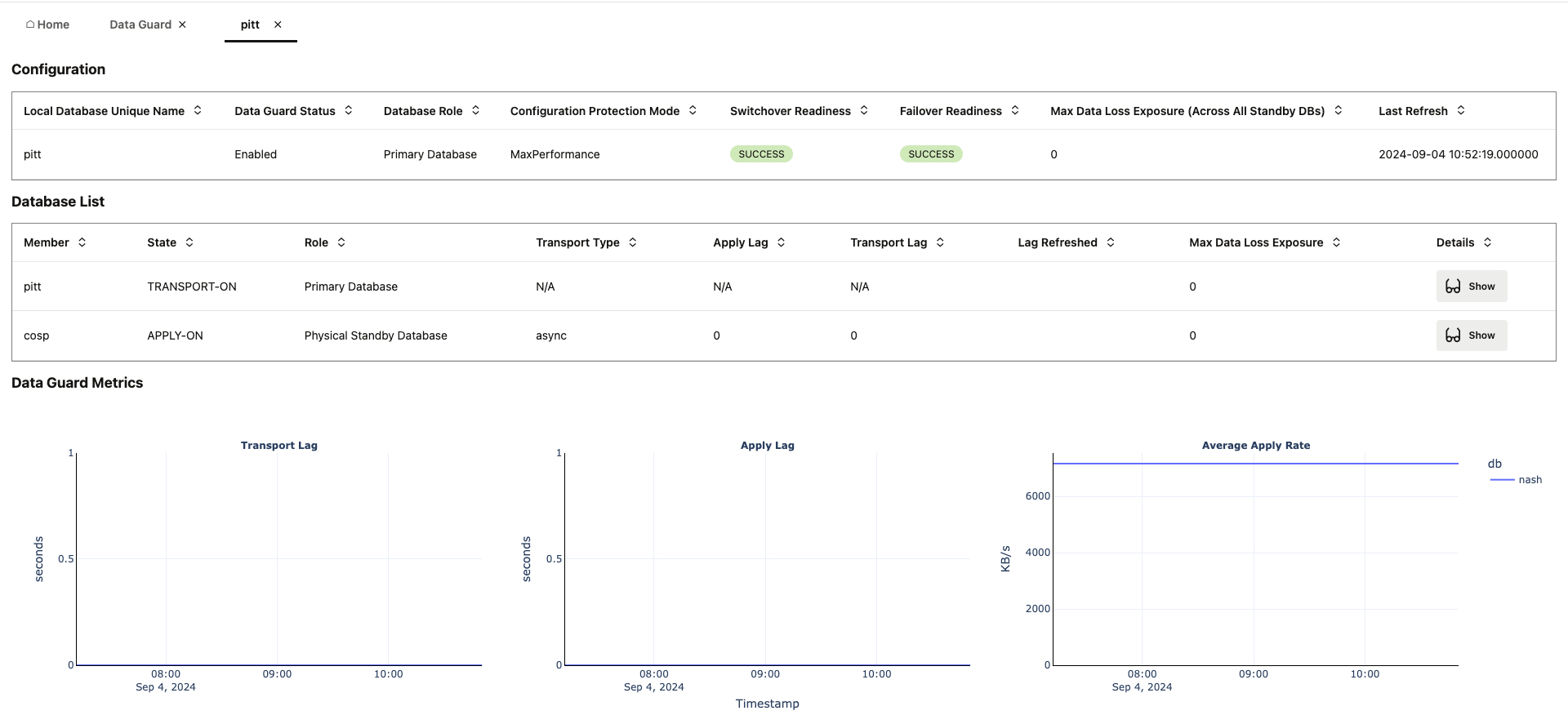
Clicking on the details button shows the Database Symmetry page, which enables comparison between primary and standby and also shows a list of Database Wait Events, with the corresponding time spent waiting. This can be used to pin-point performance bottlenecks.
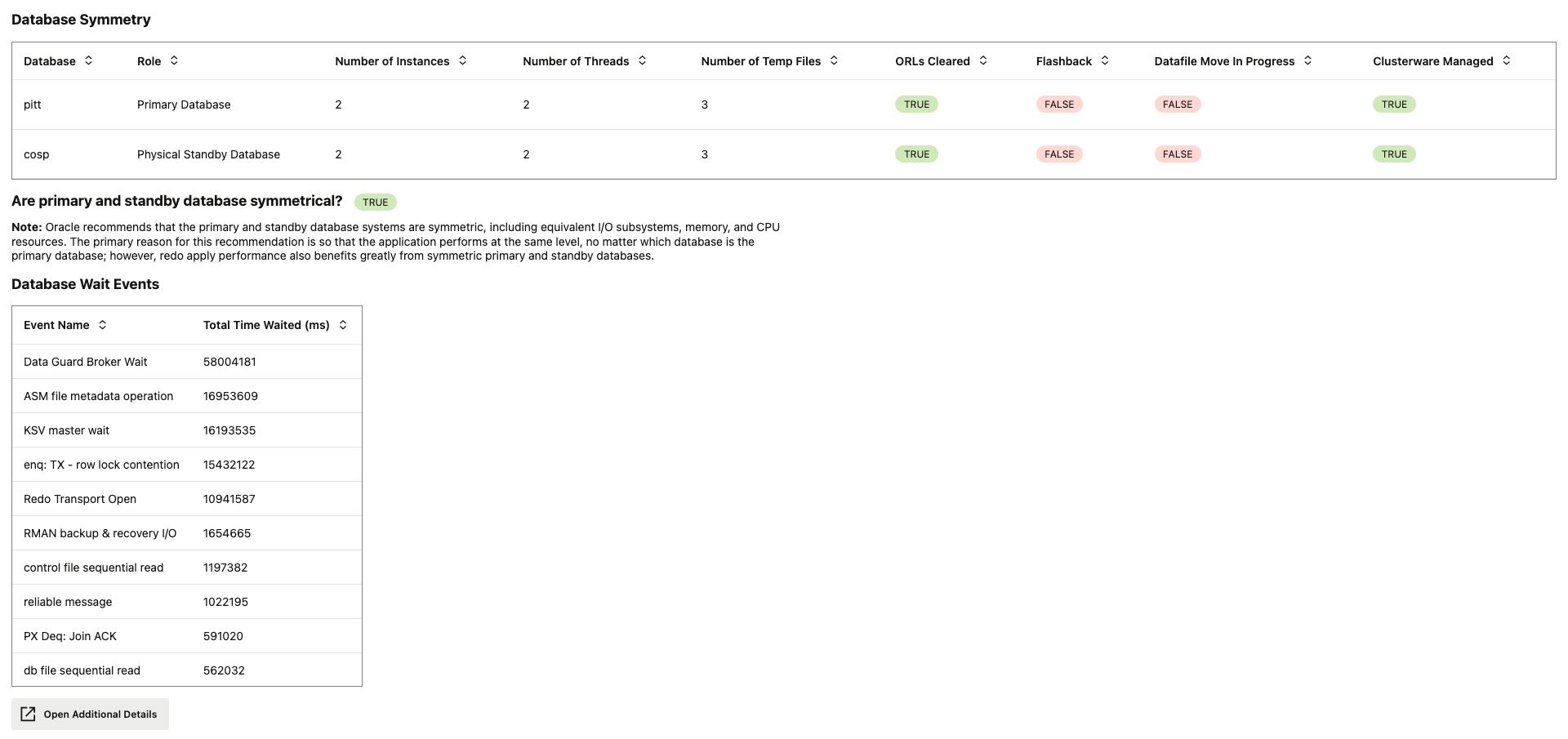
Database Wait Events and Log Switches are local to the system where the Insights report is generated, to view a complete picture create Insights reports on both Primary and Standby.
To create an Insights report with Data Guard run the command:
ahf analysis create --type insightsFor see the user guide for more information on AHF Insights
Database Monitoring Via Database User Credentials
AHF can now monitor databases using a configured username and password instead of as SYSDBA.
AHF provides monitoring and alerting of databases anomalies. Previously AHF would perform this monitoring by connecting to the database as SYSDBA using OS authentication. However, this was not possible if OS authentication was disabled.
On Oracle Databases of 19.0.0.0.0 and above, AHF can now monitor the database using a configured username and password. This eliminates the dependency on OS authentication and reduces generation of audit records.
If you have already configured a user and password for use by AHF, this will be used.
To configure AHF to use a specific username and password use:
ahfctl setpasswordSee the User Guide for more information on configuring database monitoring
Best Practice Reporting for Latest Security Risks
AHF now includes Database Security Assessment (DBSAT) version 3.1 recommendations in best practice recommendations shown in Orachk and Exachk reports.
Oracle Database Security Assessment Tool (DBSAT) provides prioritized recommendations on how to mitigate identified security risks or gaps within Oracle Databases. DBSAT profiles the security and compliance posture of databases by evaluating the current state, including configuration, discovering sensitive data, and more.
AHF includes DBSAT recommendations within Orachk and Exachk reports. This makes it easy to get all cluster best practice recommendations including security in a single report without any separate downloads or installs.
As of AHF 24.9, the DBSAT version included has been upgraded to DBSAT 3.1.
To generate an AHF best practice report including security recommendations run:
ahfctl compliance -profile securityTo generate an AHF best practice report including security recommendations as well as complete health of the system run:
ahfctl compliance -includeprofile security
View the user guide to learn more about AHF best practice checks.
New Best Practice Checks
24.9 includes the following new best practice checks for both Orachk and Exachk:
- Verify the SYS and SYSTEM Accounts Are Using the DEFAULT Profile
- Verify the DEFAULT Profile Parameters
- Verify EXECUTE Privileges Exist in the PUBLIC Role:
Then this new check is included for just Orachk:
- Verify elevated priority for database LMS processes
All checks can be explored in more detail via the Health Check Catalogs:
Read more about best practice compliance checking with Exachk and Orachk.
Latest Third-Party Libraries
AHF has upgraded the versions of third-party software libraries to fix Common Vulnerabilities and Exposures (CVEs).
AHF 24.9 has upgraded the versions of many third-party libraries. The following third-party libraries are upgraded due to CVEs:
- Papermill upgraded to 2.6.0
- tqdm upgraded to 4.66.4
- aiohttp upgraded to 3.10.5
- Python upgraded to 3.12.5
- OpenSSL upgraded to 3.0.15
- Cryptography upgraded to 43.0.1
See the user guide for more information on third party usage.
Recent AHF Features
AHF releases a new version every month, here are recent new features by release:
AHF 24.8
- Share Problem Summary as Text & Detect New Problems
- AHF Balance Disaster Recovery Support
- Timeline & OS Issues Usability Improvements
- New Best Practice Checks
AHF 24.7
- Upgrade Java Independently of AHF
- Improved Platinum Monitoring and Patching
- Store Exadata Infrastructure Details for Best Practice Checking
- New Problem Summaries
AHF 24.6
- Node Evictions & Performance Issues Are Easier to Resolve
- System Health Metrics Available on First Failure
- Component-Level Grouping of Events and Faster Performance
- New Exachk Best Practice Checks
AHF 24.5
- Data Guard Health Report Included in AHF Insights
- New Security Checks Section for Orachk and Exachk
- Run a Balance Fleet report for the Clusters in an Enterprise Manager Group
- Discovery of Nodes and Switches on Dom0
- New Best Practice Checks
AHF 24.4
- Preserving Oracle Database 23ai Availability and Performance From Day One
- Node Eviction Detection and Resolution
- Ability to Downgrade
- Automatic Diagnostic Collection for Database Performance Anomalies
- Faster Insights Report Generation
- Accessibility Improvements for Insights
- Diagnose and Resolve ORA-04030
- New Best Practice Checks
AHF 24.3
- Diagnose and Resolve ORA-04031 and ORA-07445 using AHF
- Insights Accessibility Improvements
- ahf CLI Output in JSON
- New Best Practice Checks
AHF 24.2
- Insights in Diagnostic Collections
- Insights for Single Instance Systems
- Component Diagnostic Purging
- Exadata Netdiag in Diagnostic Collections
- Combine Diagnostics From All Machines in a Single Zip File
- Latest Python & Java Third Parties
Get started with Autonomous Health Framework today
To get started today download Oracle Autonomous Health Framework.
